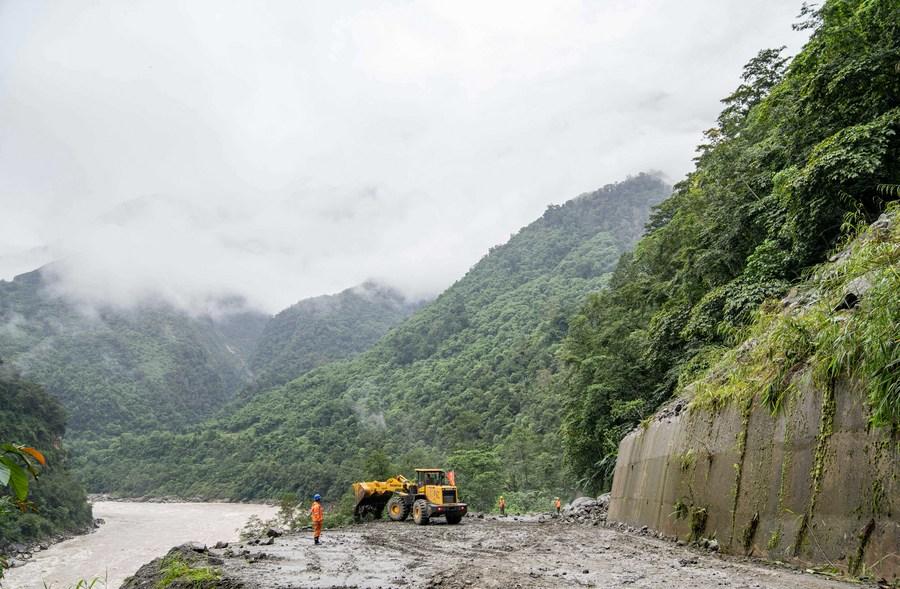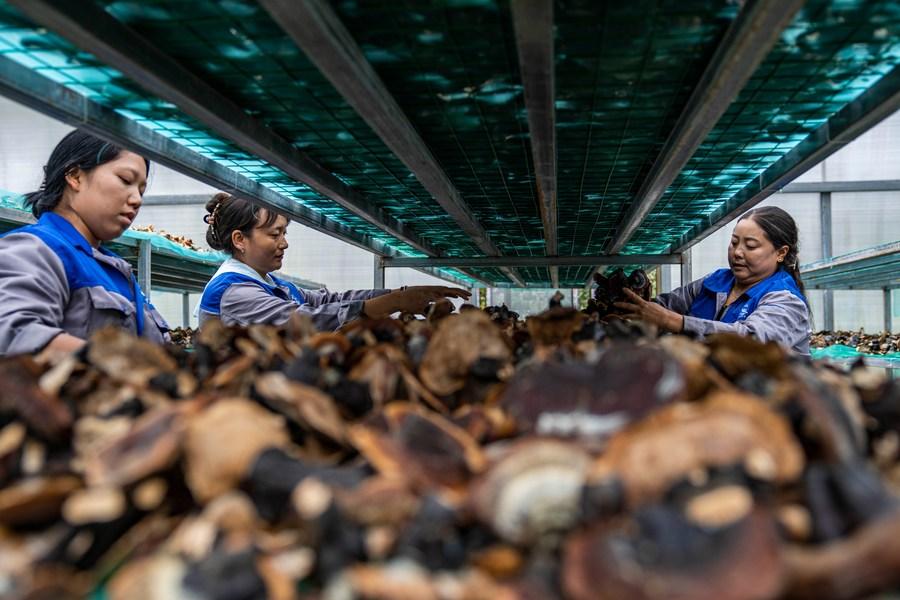Xinhua | November 3, 2023
What does being connected to the national road network mean for people in the county of Medog, which is tucked away deep in the Himalayas in southwest China's Tibet Autonomous Region?
For Namgyal, born in the 1960s, obtaining essential supplies from a location over 100 km away required an arduous eight-day round trip through mountainous terrain. Similarly, Padma Chodron, born in the 1980s, embarked on a four-day journey by foot and bus to reach Lhasa for meetings.
In stark contrast, it takes Padma Yangdron, born in the 2000s, only one day to return to school in Shanghai, some 4,000 km from Medog, via a combination of bus and plane.
These three generations, each navigating distinct methods of traversing the challenging terrain, illustrate the remarkable transformations in Medog's transportation infrastructure.
A decade ago, a highway connecting Bome to Medog was inaugurated, marking the end of Medog's isolation. People there finally had a reliable means out of the mountains.

This aerial photo taken on Oct. 13, 2023 shows a view of Medog, southwest China's Tibet Autonomous Region. (Xinhua/Sun Fei)
ROAD IMPOSSIBLE
Driving along the highway to Medog, one must cross a snow-capped mountain of nearly 5,000 meters in altitude, and go all the way down along the Yarlung Zangbo River. Most of the time, vehicles need to move carefully on this "cliff-hugging" highway.
"Once you experience the Medog road, you will not be afraid of any sufferings in the world," is a popular saying in this county.
"Before the opening of the highway, we had to rely on mountain trails, ziptreks, and wooden and rattan bridges," said Buga, a native of Medog. "All the supplies in the county, from salt and grain, to medicine and textbooks, had to be laboriously carried in by people and horses. Things were unthinkably expensive, cement was sold by the kilogram, and even rice had the smell of horse sweat."
Pudolgar started working as a porter at the age of 12, and each delivery would demand more than 10 days of his strenuous efforts.
"At that time, we often faced life-and-death trials, and some roads were so narrow that only half a foot could fit. Once a shabby wooden bridge suddenly broke, and I could only watch my fellow being swept away by the rushing river. I almost fell off a cliff several times myself," he recalled.
Gao Yong, now a truck driver, said over 10 porters once combined to carry a seriously ill patient out to a hospital. "They took turns to carry the patient, each half an hour. But tragically, the patient died before they reached the hospital."
"For many years, a drivable highway was the desire and expectation of the people of Medog," said Pudolgar.

Highway maintenance crews rush to clear a road in Medog, southwest China's Tibet Autonomous Region, Oct. 12, 2023. (Xinhua/Sun Fei)
ROAD OF BLOOD
China since 1961 repeatedly organized preliminary surveys for a highway to Medog. According to the "History of Highway Traffic in Tibet," the first batch of surveyors climbed to the top of a mountain near Medog but could not find an easy way down to the county. They decided to turn back.
In 1965, the Medog highway construction headquarters was established in Lhasa, mobilizing more than 700 workers. However, the daunting nature of the construction project led to a premature halt.
The regional government of Tibet decided in 1975 to make another attempt at building the highway. However, a large mudslide destroyed a considerable section of the newly-built road, while vehicles, machinery and bridge steel frames had to be abandoned as they were trapped and irretrievable.
In 1990, the highway construction effort resumed and by February 1994 an earthen road to Medog had been built. While several vehicles managed to successfully venture into the county seat, their return route was damaged by subsequent mudslides.
A new highway reconstruction project began in April 2009. This marked the fifth attempt to construct the Medog highway. Four and a half years later, the highway finally opened.
In order to build the 110-km highway, more than 200 lives were lost in the course of a half century.
According to statistics, since its opening, the highway has endured 652 continuous heavy rainfalls, 265 heavy snowfalls, 258 slope and subgrade collapses, 394 mudslides and 71 avalanches. Therefore, efforts to upgrade the highway have never stopped over the past decade.
"The road builders in the past made history with flesh and blood. Now, as we take over this highway, we must maintain and protect it well to ensure its smooth operation," said Jampa Phuntsog, who is in charge of highway maintenance.

This aerial photo taken on Oct. 15, 2023 shows a tunnel exit of a highway connecting Bome with Medog, southwest China's Tibet Autonomous Region. (Xinhua/Sun Fei)
ROAD TO PROSPERITY
The highway, a miracle for Medog, has since sparked many changes there.
Sherab Tsomo still remembered the significant effort it required for her to go out and study. Sherab Tsomo and her father took wood knives and dried food, carried schoolbags and bedding, and spent several days and nights on the journey out of the mountains.
"Looking at my feet full of blood blisters and dozens of wounds from leeches, I made up my mind to never come back," she said.
However, after the completion of the highway, Sherab Tsomo, always keeping her hometown in heart, decided to return to Medog to start a business.
"Medog is rich in bananas, lemons and other fruits. In the past, they could not be sold due to lack of accessibility. Now, with the convenience of the transportation, they can find markets far and wide," she said, adding that she ventured into fruit e-commerce and sold more than 1,500 kg of dragon fruit this year.
Sherab Tsomo is one of many people who have opted to return to Medog. Some college students have chosen to go back there after graduation, and are now contributing to the county as civil servants, teachers, doctors and business management technicians.

Workers dry lingzhi mushrooms at an under-forest resources planting cooperative in Medog, southwest China's Tibet Autonomous Region, Oct. 12, 2023. (Xinhua/Sun Fei)
What is even more remarkable is that individuals originally not from Medog have decided to make it their home.
Konchog Tsering from the county of Zayu some 400 km away, has established an under-forest resources planting cooperative in Medog, and mobilized local people to plant commercial edible fungi.
"Without the highway, how can there be industrial development?" Konchog Tsering said. "Now our products can be sold to Beijing, Guangdong and other places, and members of the cooperative can increase their income by more than 10,000 yuan (about 1,366 U.S. dollars) every year."
Wu Shengli, from Sichuan Province, has been running a restaurant in Medog for 10 years.
"My initial plan was to make enough money to return to my hometown. However, seeing the growing ease of travel, I decided to stay," Wu said. He married a local woman, and they now have two children.
Moreover, there is additional promising news for this county. The main work on another highway connecting Medog has been completed, and the distance between Medog and the city of Nyingchi will be slashed to 180 km from the original 346 km.
What was once a remote mountain county, an adventurer's haven, has now evolved into a thriving tourist destination.
According to Fu Yongbo, Party secretary of Medog, the local GDP had increased from 260 million yuan in 2012 to 790 million yuan in 2022. The county received no more than 20,000 tourists in 2012, but that number jumped to 348,000 in the first nine months of this year.

